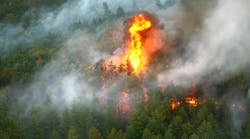Sustainable utility vegetation management (UVM) includes practices capable of maintaining safe and reliable power to society indefinitely, while enhancing environmental quality, making the most efficient use of nonrenewable resources, establishing natural biological cycles and controls, and enhancing quality of life for adjacent communities. Sustainability is a long-term responsibility with environmental, economic and social dimensions, and encompasses the concept of stewardship — the responsible management of resources.
Does your UVM program have the capacity to endure? Is it focused on the long-term maintenance of responsibility, and does it include environmental, economic and social dimensions? Or are you managing for short-term goals without regard for the long-term impact of those decisions?
The Northeast blackout of 2003 changed the UVM world forever — for the better and for the worse. Because of the blackout and the ensuing regulations, many utilities have been able to secure much-needed funding to support their integrated vegetation management (IVM) programs and make them truly sustainable. Unfortunately, some utilities thought the only way to be sure that they would have zero violations was to clear-cut their rights-of-way (ROW).
Removing all the trees in ROW may seem like a good idea, but a one-size-fits-all approach is rarely a good idea. Furthermore, removing all trees is inconsistent with ANSI A300 (Part 7) IVM, and it eliminates the need for professional judgment. Using regulations to justify clear-cutting only weakens the argument and creates suspicion among a wide range of stakeholders. This can have disastrous results as communities band together and become educated about the regulations, which do not require clear-cutting.
The days of utilities being able to have a program that does not consider all the environmental, economic and social impacts of their decisions are over. It's time to do the right thing.
Let's take a look at the environmental, economic and social aspects of a sustainable vegetation management program.
Environmental Sustainability
Environmental sustainability begins with an adaptive strategy for vegetation management. That means developing a site-specific plan based on actual field conditions, rather than on some hypothetical condition that may never occur at a specific location. It harkens back to the days when tree contracts required a specific amount of clearance, regardless of the tree species, age, location along a span or the site conditions.
Most managers would agree that we should be removing trees that could cause a grow-in outage. To figure out which trees those are, we need to know two things: how tall a particular tree species can grow in a particular location and the minimum ground-to-conductor clearance at that location. The first question requires professional judgment and the second question requires technical data (conductor type, loading, length of span, terrain, etc.).
Minimum ground-to-conductor clearance should not be based on theoretical minimums or on dated engineering drawings, but on actual in-service field conditions.
Perhaps one of the most underappreciated uses of LiDAR (light detection and ranging) is to determine what the actual minimum conductor clearance is at any point along a transmission line. With this information, utilities can identify which trees are incompatible and which ones are compatible. Removing only incompatible trees saves money, time and energy, and reduces the environmental and social impacts of a ROW program.
Remember Bramble & Byrnes? The results of their research have never been more valuable than they are today. Their research demonstrated the environmental benefits of using IVM to manage ROW in a sustainable manner. Their research showed that by using IVM, including the use of herbicides, a sustainable plant community can be created that resists invasion by trees and thus reduces necessary inputs and environmental impacts over time. Their wire zone-border zone approach benefits wildlife habitat and can offer safe harbor for threatened and endangered species, as well as provide wildlife connectivity corridors, which are particularly important in urban and suburban areas.
Invasive species have become a hot topic in recent years and increasingly are required to be addressed in FERC licenses and U.S. Forest Service permits. Incorporating herbicides into your IVM program provides an essential tool in the successful management of invasive species. The invasive species issue can allow you to use herbicides on some properties where, in the past, they were not an option. Once native low-growing species are established, the utility will have a vegetation type that naturally dominates the site, resists tree invasion and reduces the need for future efforts.
Economic Sustainability
If some of your ROW have been cleared and some have not, and you're focused on those that are not cleared, then your program isn't economically sustainable. Your first priority should be maintaining ROW that are already clear. Doing anything else is like painting your house when your foundation is being eaten by termites.
Manual and mechanical clearing costs are at least 10 times greater per acre than follow-up herbicide applications — and that's only part of the story. It doesn't take into consideration the fact that herbicide costs decrease over time, both because there is less incompatible vegetation to be treated and because cycle time between applications increases. The same cannot be said for manual or mechanical costs over time, because workload actually increases while cycle time stays constant. Mechanical and manual clearing also result in dramatic and immediate impacts for wildlife and public relations, which aren't typically or easily translated into economic costs.
Including herbicides as part of your long-term plan has numerous other environmental and safety benefits when compared to relying on manual and mechanical techniques alone. Manual and mechanical techniques have greater potential to result in soil compaction from heavy equipment use; damage to sensitive wetland areas; worker and environmental exposure to petroleum products, which are more toxic than many herbicides used for ROW maintenance; physical injury from sharp tools and equipment; increased fire risk; and repeated, significant alteration of wildlife habitat.
Social Sustainability
Do your vegetation management activities improve your relationships with affected landowners and the community? If they do not, then you are making the situation more difficult for the rest of your company and whoever is unfortunate enough to be the next utility person who needs to do work in that location. You might even be damaging your relationship with other parts of your company or making vegetation management more difficult for others in your department.
When you damage your relationships with property owners, they will find ways to make your life difficult, perhaps by refusing to allow you to use herbicides, requiring you to stick to the letter of the easement document, contacting the local media and local politicians, or filing a lawsuit. Any legislation resulting from your actions will affect other utilities statewide.
An adaptive strategy works with people, too; one size doesn't fit all where people are concerned. Are you really going to take the same approach in someone's backyard as you would in a forested situation? Can you leave some trees in some situations? For example, if there is a key tree in someone's yard in the city, can you prune it, treat it with tree-growth regulators and inspect it more frequently? Can you leave each property owner one key tree? Are there other options? Shouldn't you be more concerned about a tree located in a remote location than one that only gets inspected once a year? Some trees, such as redwoods or eucalyptus, have to removed whenever they can potentially cause a grow-in outage and are located directly under the conductors.
Communication is key and is fairly simple. Be honest. Don't hide behind regulations. Keep your word. Treat people and their property with respect. Listen. If you make a mistake, admit it. Find common ground if there is some. Focusing on long-term goals should mean you won't be on their property as often in the future. Maybe they're concerned about fire danger or interested in wildlife or concerned about invasive species.
A vegetation management program requires environmental, economic and social sustainability in order for the program to be truly sustainable. All three components together form a triangle. If even one of those points is lacking, you're left with two points, a flat line and a program in need of resuscitation.
Tips for Developing a True Sustainability Approach
- IVM is the cornerstone of a sustainable program
- Employ professionals who understand and can implement an adaptive strategy
- Develop your Transmission Vegetation Management plan as required as part of FAC-003 and base it on IVM and adaptive management, revising as needed
- Build support internally before you need it
- Build support externally where you can
- Build trust
- Start in locations where you're less likely to encounter opposition (but don't be surprised if you encounter it in places you haven't anticipated)
- Build on your successes
- Learn from your mistakes
- When working in controversial areas, start small
- Don't use regulations and the easement/ROW document as the only defense for your program
- Be flexible and be patient
- Repeat
Editor's note: This article was independently written by Nelsen Money, as contracted by the editorial director of Transmission & Distribution World. Money, president of NRM-VMS Inc., has more than 38 years of utility vegetation management experience. He is an ISA Certified Arborist/Utility Specialist, California Licensed Professional Forester and California Licensed Pest Control Advisor. He is a past president of the Utility Arborist Association, and has been speaker and writer for many professional organizations and publications.

